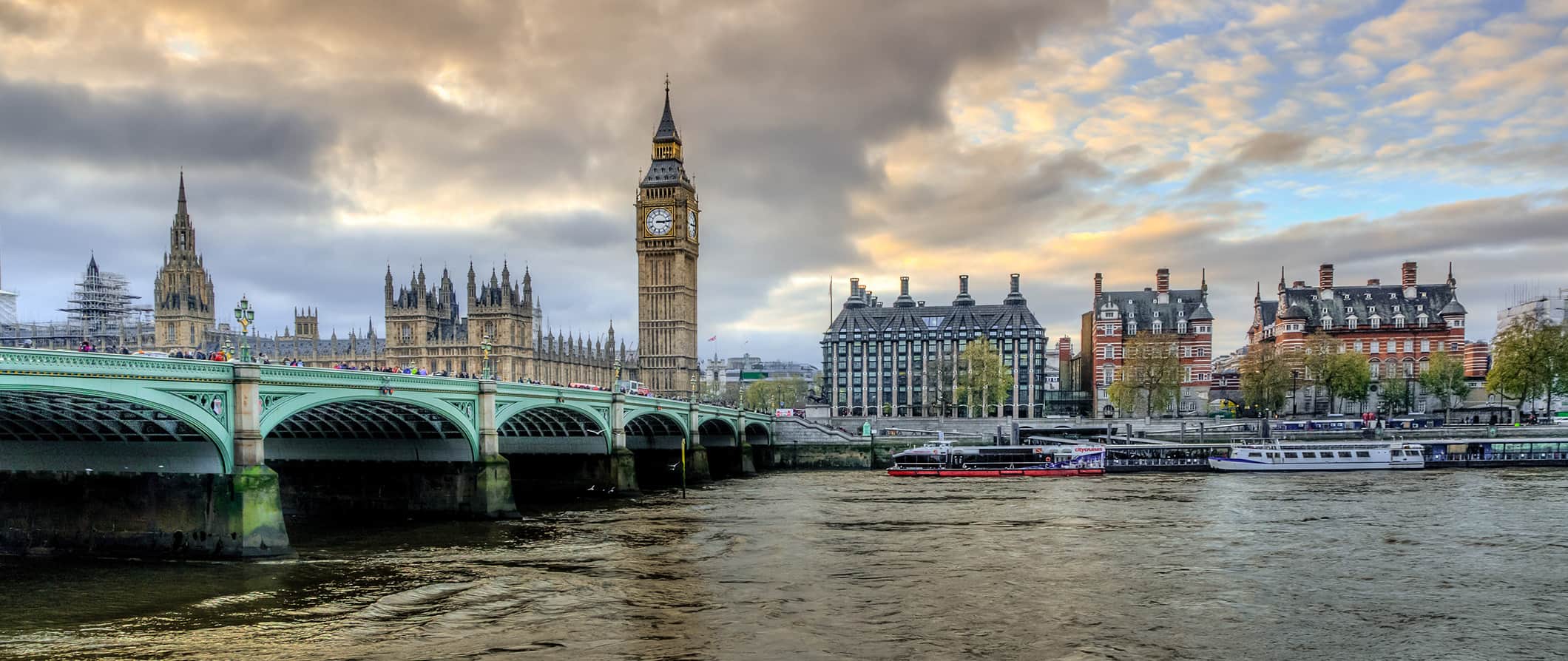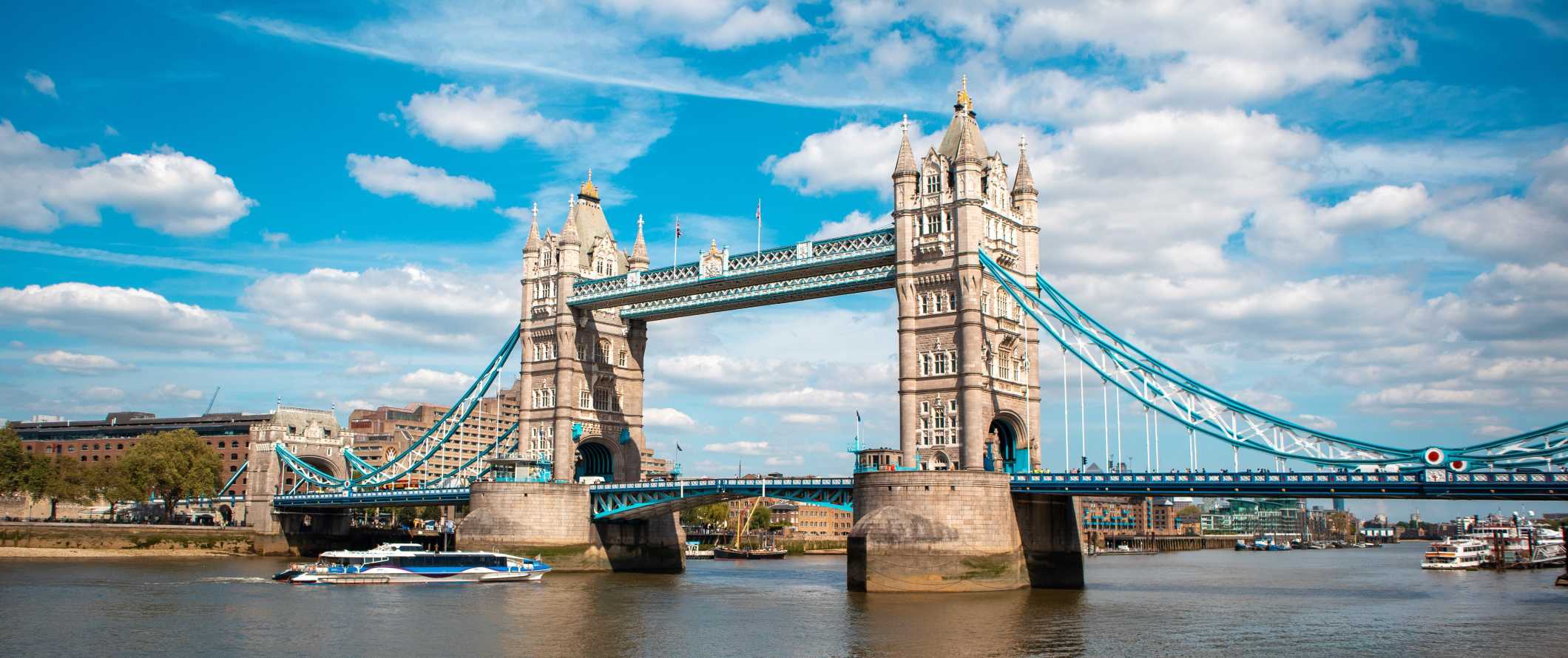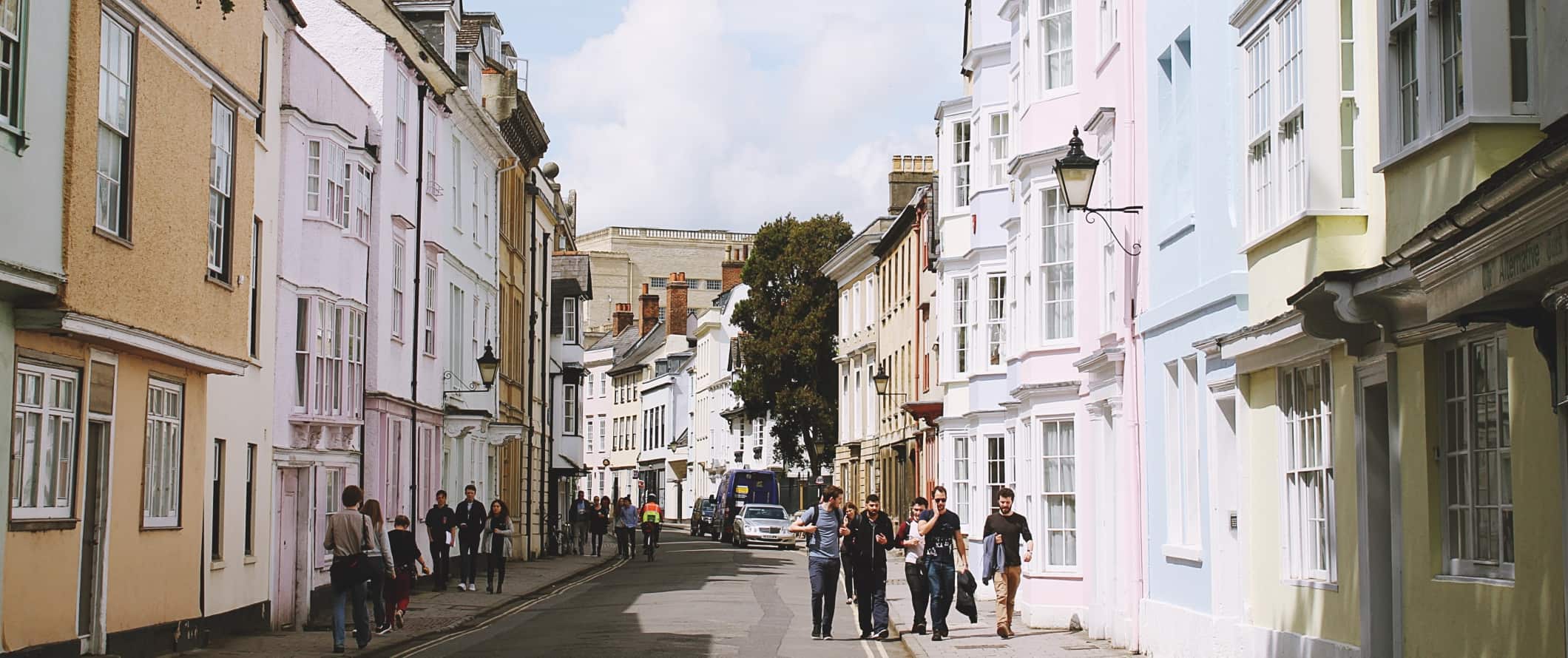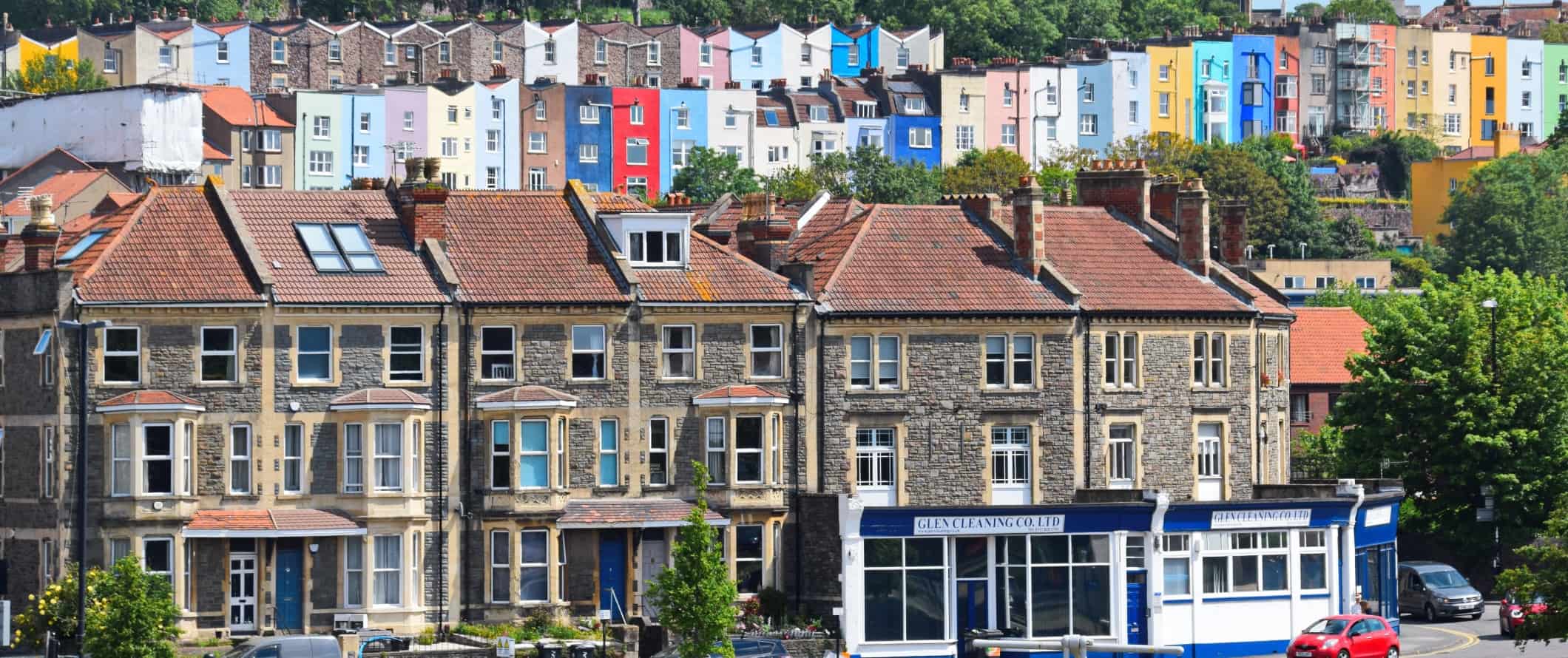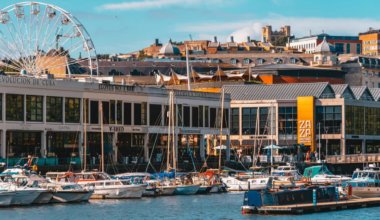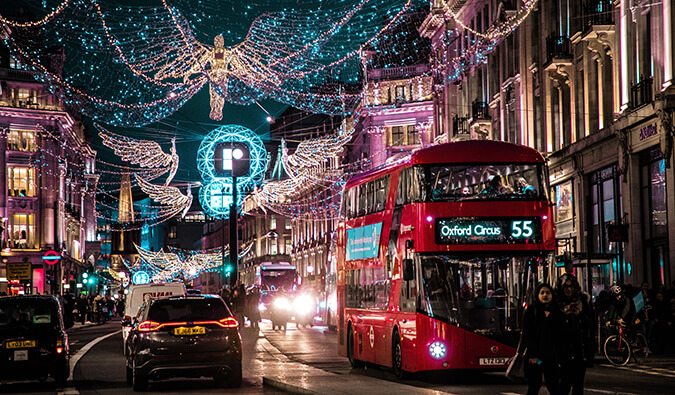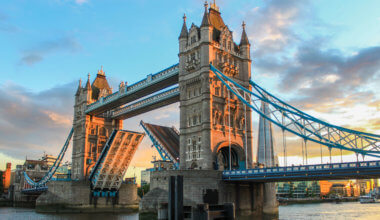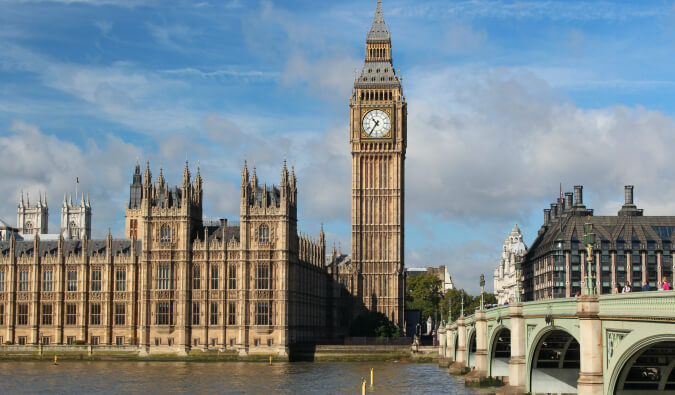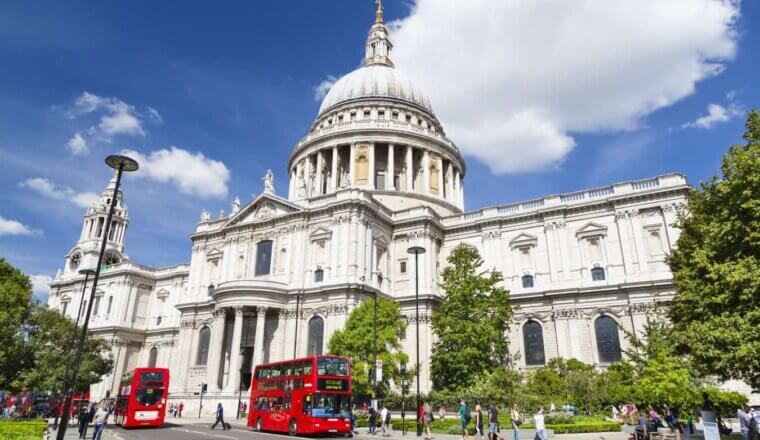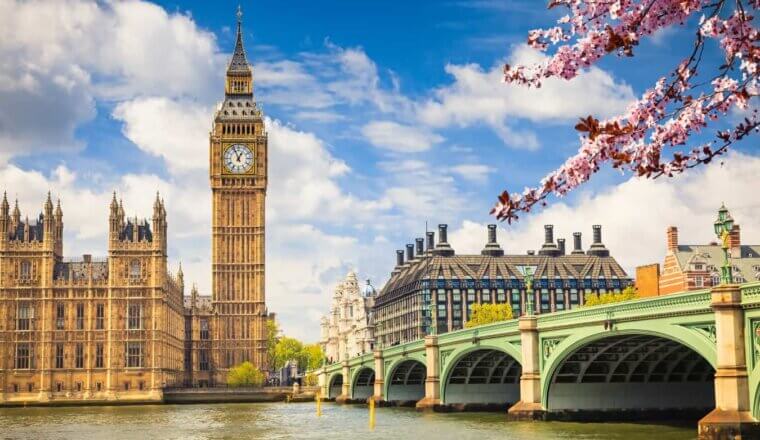England is one of the most popular tourist destinations in the world. While most travelers tend to stick to London (which is understandable as it’s a great city!), the rest of the region has a lot to offer and sees a fraction of the crowds.
In fact, backpacking around England was one of the highlights of all my travels in Europe.
England’s smaller cities, like Bath and Oxford, are both fascinating and culturally rich. (And, since they aren’t as crowded as London, they’re a bit cheaper too.)
Liverpool, the birthplace of The Beatles, boasts a rich musical history while the countryside has fascinating estates and natural beauty. There’s the mountainous north, the rolling hills of Lancaster and Cornwall, Stonehenge, Hadrian’s Wall, and Tudor cities like Chester.
In short, there is a ton to see and do in England. This England travel guide can help you plan your trip, save money, and make the most out of your time here!
Table of Contents
Click Here for City Guides
Top 5 Things to See and Do in England
1. Tour London
You can’t go to England without visiting London — it’s one of the most popular cities in the world. It’s home to charming pubs, world-class museums, tons of history, some of the best theater performances in the world, a diverse population, incredible food, and a wild nightlife. It might be a city that often breaks the bank, but fortunately, London has a plethora of free markets, museums are often free, and it has a ton of relaxing parks that you can enjoy on a budget. There are lots of free walking tours here too!
2. Drive the coast
England’s coastal towns make for a relaxing holiday (especially if you have a vehicle). The most popular destination is Brighton, well-known for its summer parties and festivals. But don’t overlook places like Weymouth, Salcombe, Dover, Hastings, St Ives, or Newquay — and that’s just a handful of them in the south of the country. You could literally spend months just discovering each new place. The towns offer everything from old-world traditional charm (think cobbled streets and Tudor houses) to bright lights and fun fairs (Brighton’s pier is similar to LA’s Santa Monica).
3. See Cornwall
Cornwall is like mini-New England — you can see why English settlers felt at home in the New World. Just like the USA’s New England, Cornwall has rolling hills, beautiful lakes, small towns, rural farms, wonderful hiking trails, tiny fishing villages, great food, and even a winery. The area has been populated since the Neolithic and Bronze Age. Eventually, the Britons (who were Celtic in origin) claimed the region, with the first written account of the region dating back to the 4th century BCE. It’s also been an important maritime region for centuries. The laid-back pace of life here is one of the reasons why it’s one of my favorite places in England. Don’t miss it!
4. Spend a day in Bath
Bath is named after the famous (and marvelously well preserved) ancient Roman baths located in the heart of the city that date back to 70 CE and were in use through to the 5th century. The audio guide by Bill Bryson is a must and adds a lot of context and details. The baths are the main attraction in town, though the abbey, Georgian and Victorian houses, and river are also nice to see. Literature buffs can also explore Jane Austen’s heritage as she lived in Bath for most of her life.
5. Explore the Lake District
Located in Cumbria, in Northern England, and about an hour from the border with Scotland, the Lake District is home to one of England’s best national parks. The lakes in the region are a result of the last ice age and receding glaciers cut the U-shaped valleys that are now filled with water. It’s perfect for hiking mountain passes and sailing around pristine lakes. It’s very popular (and crowded) during the summer. It is to northern England what Cornwall is to the south: a natural, rural paradise that embodies the best of England and, outside of Cornwall, it’s my favorite region in England.
Other Things to See and Do in England
1. See Buckingham Palace
Buckingham Palace, home to the Queen of England, is a fascinating sight that’s only open to the public during the summer. If you can’t (or don’t want to) visit the palace, you can catch the changing of the guards at 11am four times a week (Mondays, Wednesdays, Fridays, and Sundays). If you want to check out the palace, admission is 30 GBP when purchased online (33 GBP on the day), while exclusive guided tours are 90 GBP. Check the Royal Collection Trust website for details on other events happening throughout the year.
2. Visit the Tower of London
Built in 1070, the Tower of London has expanded many times over the years. It was built as a double-leaf bascule bridge in the middle (both sides lift up) to maintain river access to the Pool of London docks while easing congestion on each side of the river. You can visit inside the tower and walk along the glass walkways. Weapons, armor, and coins were made here until 1810 and today you can view the famous crown jewels, walk the battlements, wander recreated medieval palace rooms, see the iconic Yeoman Warders (known as the Beefeaters as they were allowed to eat as much beef as they wanted from King Henry VII’s table), and spot the legendary black ravens that live in the tower. Skip-the-line tickets are 29.90 GBP. Be aware that lines are long so it’s best to plan ahead.
3. Relax in Brighton
Brighton is a great little seaside resort town on the southern coast of England that’s perfect for a weekend getaway. Considered the hippest city in the UK, Brighton is known for being quirky, bohemian, artsy, and very LGBTQ-friendly. It’s a popular summer destination for locals who come here to relax on the beach, enjoy the fleeting summer sun, and wander the pier where there are amusement rides, carnival-style stalls, and street food.
4. Listen to music in Liverpool
Liverpool has spectacular museums, but as the World Capital City of Pop, the real reason to go is for the music, or more specifically, for The Beatles. The Beatles Story museum has all kinds of memorabilia and information about the famous band, who were from Liverpool. Besides the music, Liverpool has a rich history and culture as well as fun pubs, so don’t sell it short.
5. Check out Chatsworth House
Located in Derbyshire, this massive and lavish mansion was built in 1549 for the Duke and Duchess of Devonshire. While there are many beautiful houses and castles throughout the UK, this is one of the most astonishing. It’s so striking in fact, that countless films and TV series have been filmed here (including Peaky Blinders, Jane Eyre, and of course Pride and Prejudice). The home has played a role in popular culture since it was mentioned in Jane Austen’s book, Pride and Prejudice in 1813. On your visit, you can wander the 25 stately rooms, stroll the 105-acre gardens, and make new furry friends in the operating farmyard. Admission to the house and garden costs 26 GBP (just the garden is 15 GBP).
6. Tour Oxford University
Founded in the 11th century in Oxford, this university is one of the oldest in the world. You can visit the many beautiful colleges within Oxford for just a few dollars, or you can take a 90-120 minute guided tour of the entire university with Bodleian Libraries (20 GBP). You can even see the colleges in which they filmed parts of Harry Potter! For art history buffs, stop in at the free Ashmolean Museum on campus for impressive Eastern and Ancient Egyptian art collections.
7. Attend the festivals
England is known for its festivals, especially during the summer. For music, be sure to check out the famous (and muddy!) Glastonbury festival or the Liverpool International Music Festival. Also, the UK has three huge annual Pride events in London, Brighton, and Manchester. This is just the tip of the festival iceberg though as every city and town has a lot on offer.
8. See Stonehenge
Stonehenge, located just 15 minutes from Salisbury, is one of the oldest man-made structures in the world (dating to 2,500 BCE!). You can’t go up to the stones anymore, but it’s quite a fascinating site, especially since we still have very little idea how they dragged the stones there. The audio tour is worth getting so you can get some historical context on the site. Admission starts at 22 GBP.
9. Visit Old Trafford
I highly recommend a visit to Manchester United’s home stadium. With over 74,000 seats, it is the largest club football stadium in the UK and the 11th largest in all of Europe. The tour is awesome and takes you below the stadium seating into the player’s lounge, and even into the pitch-side dugout. Dig deeper into some football (aka soccer) history at the onsite museum. Admission is 35 GBP.
10. Admire Ely Cathedral
Also known as the ‘Ship of the Fens,’ this cathedral is visible everywhere in the small city of Ely in Cambridgeshire (and from miles around too). Originally built in the 12th century, it’s renowned for its Romanesque architecture, complete with a stunning entrance and an octagonal lantern tower. The Lady Chapel is the largest in all of England. The cathedral is also home to the National Stained Glass Museum, whose collection spans 800 years and includes stained glass from across the UK and Europe. Visiting the cathedral only costs 9 GBP (online, or 10 GBP on the day), entry to the museum is 5 GBP. Booking in advance is recommended if you want to join one of the tours which cost between 1.50-12 GBP.
11. Relax in Greenwich Park
Considered to be one of London’s largest parks, it is also one of the most beautiful — and a perfect escape from the city’s bustle. There are several historic sights here as well as a rose garden, meandering pathways, a tea house, the Royal Observatory, the National Maritime Museum, a café, and even a deer park. It is the oldest enclosed royal park in London and a relaxing place to spend a few hours with a book.
12. Hike Hadrian’s Wall
Declared a World Heritage Site in 1987, Hadrian’s wall has been standing since the 2nd century. It was built by the Romans to keep the Celts out of Roman England (though that didn’t work so well). While you can make a brief visit to see the fortifications and ancient walls in many spots of the country, if you’re up for it, you can also hike the entire 83-mile (135-kilometer) length of the wall itself (most people do it in 6-8 days).
13. Go to Salisbury
Not far from Stonehenge is the beautiful town of Salisbury. Just 1.5 hours from London by train, it has a breathtaking 750-year-old cathedral that is home to the Magna Carta and tombs dating back to 1099. Salisbury is one of the few places that wasn’t bombed during the World War II Blitz so it is beautifully preserved. Cathedral Close and Market Square are both worth visiting in Salisbury as well as Old Sarum (what is thought to be the original site of Salisbury) and Salisbury Museum.
14. Stay in Chester
I love an under-visited destination and, for me, Chester is one of those places. Chester’s center looks like something out of an old novel by Charles Dickens. The homes in Chester are typically Victorian in design and the old taverns, hotels, and little shops all have retained their charm and original look. There’s plenty to do in Chester, including walking along the city walls and seeing the rows of medieval houses that showcase the historic architecture. Chester Cathedral is over 1,000 years old and well worth a visit (it has been added to and restored but has kept its medieval feel). For something a little more contemporary, go on a river cruise.
15. Visit the colleges at Cambridge University
Like Oxford, Cambridge University is made up of different colleges. Founded in 1209, the University is an architectural delight and wandering around the many buildings in the city. Most notable include the stunning buildings at Kings and Queens Colleges as well as the iconic quads at St. Johns and Trinity. There are lots of walking tours to choose from if you want to learn more about Cambridge’s history and some are even led by the students themselves. Expect tours to last around 90 minutes and cost 20 GBP.
16. Enjoy afternoon tea
Tea is a scene unto itself in England. With a history dating back through the centuries, this tradition can be enjoyed at every level of your budget. Starting with just the drink, you can find quaint tea shops literally all over the country. There you can try different types of tea and a selection of cakes to go with it should you need a sweet treat. In Devon and Cornwall, you can have cream tea which is tea with scones, cream, and jam (although these are now often served in other places too). Afternoon tea, or high tea, is a more lengthy affair and comes first with finger sandwiches and tiny savory pastries, then with scones (with cream and jam) and little cakes. Some places offer a glass of champagne to go with it. Most traditional tea houses offer afternoon tea but if you’re after more of a sense of occasion and your budget can stretch to it), the big hotels also offer it every day.
17. Visit Bristol
Many people only pass through Bristol on their way to Bath but it’s really worth a visit of its own. With a population of 500,000, Bristol is a hip college town with amazing eateries, great food, wonderful things to see, lots of green space, and plenty of things to do. Aside from taking a walking tour (my must-do in any city!), some of my favorite things to do include a tour of Bristol’s Romanesque Cathedral that was built in 1148, wandering King’s Street, and admiring Clifton Suspension Bridge. Bristol has a great museum and art gallery that is worth a visit and I also really enjoyed St Nicholas’ Market. Other things worth doing include the S.S. Great Britain, the Avon Railway, and Blaise Castle.
For more information on specific cities in England, check out these guides:
England Travel Costs
Accommodation – Hostels cost 10-30 GBP a night for a dorm room. Amenities usually include free internet, breakfast, a common room, TV, and kitchen facilities. Private rooms in hostels start at around 50 GBP and go up from there.
Campgrounds can be found all around the country, and most have basic facilities (such as bathrooms, electricity, and Wi-Fi). Expect to pay 10-20 GBP per night for a place to pitch your tent.
Budget hotels offer similar amenities and start around 60-80 GBP per night for a twin room but can be more like 120 GBP in peak season. Apartment rentals (like Airbnb) cost anywhere from 35-90 GBP per night for a private room depending on the city, while entire apartments/homes start around 90 GBP per night but average 110-120.
Food – While British cuisine has evolved in leaps and bounds in recent years, it’s still very much a meat and potatoes country. Fish and chips remain a popular staple for both lunch and dinner while roasted and stewed meats, sausages, meat pies, and the quintessential Yorkshire pudding are all common options as well. Curry (and other Indian dishes, such as tikka masala), are super popular too.
A kebab costs around 5-6 GBP, burritos and sandwiches cost 6-10 GBP and traditional fish and chips cost about 10 GBP. Indian and Asian food can be purchased for 8-10 GBP. Pizza is usually 8-10 GBP. Fast food (think McDonald’s) is around 6-7 GBP for a combo meal.
A meal at a casual pub or restaurant costs 12-16 GBP and you can expect to pay at least 30-35 GBP for a three-course menu with a drink in a mid-range restaurant. A meal in a higher-range establishment costs upwards of 70 GBP.
Beer is around 6 GBP while a latte/cappuccino is 3-3.50 GBP. Bottled water is about 1.20 GBP.
A week’s worth of groceries costs around 40-60 GBP. This gets you basic staples like rice, pasta, veggies, and some meat. The best places to buy cheap groceries are Lidl, Aldi, Sainsbury’s, and Tesco.
Backpacking England Suggested Budgets
On a backpacking budget, you need at least 55 GBP per day. On this budget, you can stay in hostel dorms, cook all your meals, limit your drinking, use public transit to get around, take the bus between cities, and take advantage of all the free sites in the country (free museums, parks, beaches, etc.). It’s a tight budget so if you want some more wiggle room, I’d add another 10-15 GBP per day, especially if you plan on drinking while you’re there.
On a mid-range budget of around 135 GBP per day, you can stay in a private hostel room or private Airbnb, cook some meals and eat out at cheap pubs or fast food stalls, do some intercity travel by train (if you book early), have a couple of drinks, take the occasional taxi, and visit some paid attractions like Westminster Abbey or the Tower of London.
On a “luxury” budget of 255 GBP per day or more, you can stay in a hotel, eat out wherever you want, drink more, take taxis and the train to get around, and do more tours and activities. This is just the ground floor for luxury though. The sky is the limit!
England Travel Guide: Money-Saving Tips
England isn’t a cheap place to visit. You’re going to spend a lot of money here, especially if you stick to cities (and London will be about 30% more expensive than the rest of the country). However, there are plenty of ways to save if you know where to look. Here are my top ways to save money in England:
- Take advantage of the free museums – Public museums offer free admission in every city throughout England and the United Kingdom. It’s a great way to learn about influential artists, immerse yourself in the country’s history, and spend a rainy day without paying a cent.
- Book early – Book all transportation well in advance. You can find fares for around 2 GBP with a little planning. Megabus not only runs buses but also provides trains throughout England and is the best option for cheap travel throughout the country.
- Get a Taste of UK card – The Taste of the UK card offers up to 50% off and 2-for-1 deals at selected restaurants. You don’t need to be a United Kingdom resident to get the card and the first month’s membership fee is waived, which is perfect for most travelers.
- Eat pub food – Eating out in England can get quite expensive, but for good, cheap, and filling meals, visit the local pubs. Most serve food, and you can get a good meal for 10-15 GBP or less. Plus, the pubs are a great way to meet people!
- Take a free walking tour – Most major cities in England offer free walking tours. They usually last a few hours and are a great way to see the city. Some tours even have a specific focus, such as history, food, or architecture. Just make sure to tip your guide!
- Eat the lunch specials – Another way to lower your food expenses is to stick to eating out during lunch only. I typically do my eating out during lunch and then cook my dinner to lower my food costs.
- Visit the cathedrals – Many of England’s cathedrals are free to enter. It’s a wonderful opportunity to see some of England’s 15th to 19th-century architecture. just make sure to dress and act appropriately.
- Get a London tourist pass – If you’re planning to do lots of sightseeing in London, the London Pass provides access to over 80 attractions via its 1-10 day passes. Other passes available include the London City Pass from Turbopass (which includes an option to add transport costs), and the London Sightseeing Pass. Compare prices and activities to see which pass is the best choice for you and your budget.
- Bring a water bottle – The tap water here is safe to drink so bring a reusable water bottle to save money and reduce your plastic use. LifeStraw is my go-to brand as their bottles have built-in filters to ensure your water is always clean and safe.
Where to Stay in England
England has tons of awesome and budget-friendly hostels. Here are my favorite places to stay in England:
- Astor Hyde Park (London)
- St. Christopher’s (London)
- YHA Manchester (Manchester)
- The Full Moon Backpackers (Bristol)
- Seadragon Backpackers (Brighton)
- Embassie Liverpool Backpackers (Liverpool)
How to Get Around England
Public transportation – England has excellent transportation in nearly every town and city, including buses, trains, and trams. Getting a travel pass is often far cheaper than buying single tickets as well. For example, in London, a one-way fare on the tube in Zone 1 costs 6.30 GBP, but getting a Visitor Oyster Card reduces that to 2.50 GBP per ride.
Train – In the United Kingdom, the National Rail service is always expensive. It’s one thing the locals love to complain about. A journey from London to Liverpool can cost as little as 25 GBP or as much as 150 GBP! Who knows? Prices flucuate a lot! The earlier you book the better.
You can use the National Rail website or The Trainline to research schedules and prices.
A Eurail Pass, which allows travelers to explore Europe by providing a set number of stops in a specific time period, might also be a good option. For more information, here’s a detailed breakdown of how Eurail passes work.
Bus – The cheapest way to travel around the country is via Megabus, where fares start at 1 GBP. You need to book at least a month in advance, but even if you miss that deal, fares are rarely more than 10-15 GBP. Flixbus also has cheap fares starting at just 3 GBP.
National Express is the other main bus company in England, and they offer great discount passes to full-time students and people under 26 years old. The passes cost 12.50 GBP and give 30% or more off adult fares.
To find bus routes and prices, use BusBud.
Flying – Domestic flights around England are cheap when booked in advance. A flight from London to Manchester or Liverpool costs around 49 GBP and takes about an hour. However, once you factor in getting to and from the airport, it ends up almost always being faster to take the train unless you’re traveling far (such as from London to Scotland).
Car Rentals – Car rentals can be an affordable option in England, costing as little as 20-30 GBP per day for a multi-day rental. Don’t forget you have to drive on the left, and most cars are standard rather than automatic. Additionally, drivers need to be at least 21 to rent a vehicle here.
For the best car rental prices, use Discover Cars.
Hitchhiking – Hitchhiking in England is very safe, but it can be a little difficult as it’s not super common here. HitchWiki is the best website for additional hitchhiking information and tips.
When to Go to England
Thanks to its temperate climate, visiting England year-round is enjoyable as there are very few weather extremes. Summer is peak tourism season, and temperatures are the warmest during this time — but rarely are they ever above 30°C (86°F). Although tourist sites and attractions are teeming with people, there’s also a great atmosphere in the air. People make the most of the warm weather, and there are tons of events and festivals happening all over the country.
Spring (late April-May) and autumn (September-October) are also fantastic times to visit, as temperatures are still warm and the crowds are a bit thinner. Plus, with the seasons changing, you either see gorgeous spring flowers in bloom or the leaves turning color in autumn. Just be prepared for a little rain.
Winter lasts from December to February and tourism crowds thin out dramatically. You can still do plenty of sightseeing, although further north (or in mountainous areas) some attractions may be closed for the season. Temperatures dip below 5°C (41°F) so dress warmly. Snow is not uncommon.
Keep in mind that England is famous for its gloomy, dreary weather. It can rain a lot, so make sure you pack some weather clothes and some waterproof gear no matter when you visit.
How to Stay Safe in England
England is very safe and the risk of violent crime here is very low. Scams and pickpocketing can occur around high-traffic areas, however, especially in London around tourist attractions like the Tower of London. Pickpockets tend to work in teams, so stay alert and be aware of your surroundings. Keep your valuables secure and out of reach just to be safe.
Solo travelers, including solo female travelers, should generally feel safe here, however, the standard precautions apply (never leave your drink unattended at the bar, never walk home alone intoxicated, etc.).
While break-ins are rare, if you rent a car, don’t leave any valuables in it overnight just to be safe.
Scams here are rare, however, you can read about common travel scams to avoid here.
If you experience an emergency, dial 999 for assistance.
The most important piece of advice I can offer is to purchase good travel insurance. Travel insurance protects you against illness, injury, theft, and cancellations. It’s comprehensive protection in case anything goes wrong. I never go on a trip without it as I’ve had to use it many times in the past. You can use the widget below to find the policy right for you:
England Travel Guide: The Best Booking Resources
These are my favorite companies to use when I travel. They consistently have the best deals, offer world-class customer service and great value, and overall, are better than their competitors. They are the companies I use the most and are always the starting point in my search for travel deals.
- Skyscanner – Skyscanner is my favorite flight search engine. They search small websites and budget airlines that larger search sites tend to miss. They are hands down the number one place to start.
- Hostelworld – This is the best hostel accommodation site out there with the largest inventory, best search interface, and widest availability.
- Booking.com – The best all around booking site that constantly provides the cheapest and lowest rates. They have the widest selection of budget accommodation. In all my tests, they’ve always had the cheapest rates out of all the booking websites.
- HostelPass – This new card gives you up to 20% off hostels throughout Europe. It’s a great way to save money. They’re constantly adding new hostels too. I’ve always wanted something like this and glad it finallt exists.
- Get Your Guide – Get Your Guide is a huge online marketplace for tours and excursions. They have tons of tour options available in cities all around the world, including everything from cooking classes, walking tours, street art lessons, and more!
- The Man in Seat 61 – This website is the ultimate guide to train travel anywhere in the world. They have the most comprehensive information on routes, times, prices, and train conditions. If you are planning a long train journey or some epic train trip, consult this site.
- Rome2Rio – This website allows you to see how to get from point A to point B the best and cheapest way possible. It will give you all the bus, train, plane, or boat routes that can get you there as well as how much they cost.
- FlixBus – Flixbus has routes between 20 European countries with prices starting as low 5 EUR! Their buses include WiFi, electrical outlets, a free checked bag.
- SafetyWing – Safety Wing offers convenient and affordable plans tailored to digital nomads and long-term travelers. They have cheap monthly plans, great customer service, and an easy-to-use claims process that makes it perfect for those on the road.
- LifeStraw – My go-to company for reusable water bottles with built-in filters so you can ensure your drinking water is always clean and safe.
- Unbound Merino – They make lightweight, durable, easy-to-clean travel clothing.
- Top Travel Credit Cards – Points are the best way to cut down travel expenses. Here’s my favorite point earning credit cards so you can get free travel!
- Take Walks – This walking tour company provides inside access to attractions and places you can’t get elsewhere. Their guides rock and they have some of the best and most insightful tours in all of England.
- Fat Tire Tours – For bike tours, use this company! They have fun, interactive tours led by expert local guides. You’ll get to see all the main sights without breaking the bank!
- BlaBlaCar – BlaBlaCar is a ridesharing website that lets you share rides with vetted local drivers by pitching in for gas. You simply request a seat, they approve, and off you go! It’s a cheaper and more interesting way to travel than by bus or train!
England Travel Guide: Related Articles
Want more info? Check out all the articles I’ve written on backpacking/traveling England and continue planning your trip:
